Caryn
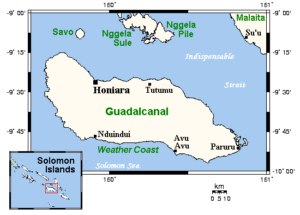 Amazingly, the islands of the world have held an importance during wartime, that most of us would never have dreamed. These seemingly insignificant places proved to be great staging places time and again, and so became places that were fought over viciously. The Solomon Islands were among those places fought over during World War II…most specifically Guadalcanal. The island of Guadalcanal is the largest of the Solomons Islands, which is in the South Pacific Ocean, located northeast of Australia. The Solomon Islands are a group of 992 islands and atolls, 347 of which are inhabited. The Solomons have 87 Indigenous languages. They were first discovered in 1568 by Spanish navigator Alvaro de Mendana de Neyra (1541-95). By 1893, the British had annexed Guadalcanal, along with the other central and southern Solomons, which made sense, since they also owned Australia. In 1885, the Germans took control of the northern Solomons, but transferred these islands, except for Bougainville and Buka (which eventually went to the Australians) to the British in 1900. So, the Solomon Islands have been transferred around some over the centuries, as most countries have been, a time or two anyway.
Amazingly, the islands of the world have held an importance during wartime, that most of us would never have dreamed. These seemingly insignificant places proved to be great staging places time and again, and so became places that were fought over viciously. The Solomon Islands were among those places fought over during World War II…most specifically Guadalcanal. The island of Guadalcanal is the largest of the Solomons Islands, which is in the South Pacific Ocean, located northeast of Australia. The Solomon Islands are a group of 992 islands and atolls, 347 of which are inhabited. The Solomons have 87 Indigenous languages. They were first discovered in 1568 by Spanish navigator Alvaro de Mendana de Neyra (1541-95). By 1893, the British had annexed Guadalcanal, along with the other central and southern Solomons, which made sense, since they also owned Australia. In 1885, the Germans took control of the northern Solomons, but transferred these islands, except for Bougainville and Buka (which eventually went to the Australians) to the British in 1900. So, the Solomon Islands have been transferred around some over the centuries, as most countries have been, a time or two anyway.
During World War II, Guadalcanal became a hard-fought-over island, with the Japanese in control in early 1943. Then, on February 8, 1943, Japanese troops evacuate Guadalcanal, leaving the island in Allied possession after a prolonged campaign. When Japan lost Guadalcanal, it paved the way for other Allied wins in the Solomon Islands.
The Japanese had invaded the Solomon Islands in 1942 during World War II and immediately began building a strategic airfield on Guadalcanal. On August 7, 1942, US Marines landed on the island, signaling the Allies’ first major offensive against Japanese-held positions in the Pacific. The Japanese response to the US Marines “boots on the ground” was to quickly launch sea and air attacks. The battles that followed were bloody and made even more miserable in the debilitating tropical heat. Nevertheless, the Marines fought hard with Japanese troops on land, and in the waters surrounding Guadalcanal, the US Navy fought six major engagements with the Japanese between August 24 and November 30. In mid-November 1942, the five Sullivan brothers from Waterloo, Iowa, died together when the Japanese sank their ship, the USS Juneau. These days they try not to put brother together in battle, but the Sullivan brothers had requested it, and so it was granted.
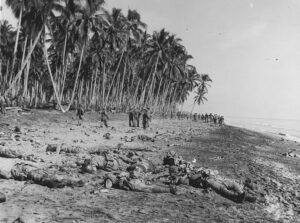
Both the United States and the Japanese suffered heavy losses of men, warships, and planes in the battle for Guadalcanal. It is estimated 1,600 US troops were killed and over 4,000 were wounded. Several thousand more died from disease. The Japanese lost 24,000 soldiers. Finally, on December 31, 1942, Emperor Hirohito told his troops they could withdraw from the area. About five weeks later, the Americans secured Guadalcanal. American authorities declared Guadalcanal secure on February 9, 1943. After the war, American and Japanese groups have repeatedly visited Guadalcanal to search for remains of missing soldiers. Some 7,000 Japanese remain missing on the island, and islanders still bring the Japanese groups bones that the islanders say are those of unearthed Japanese soldiers.
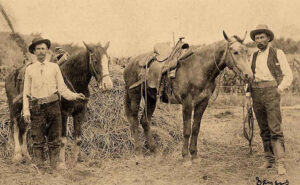 Charles Angelo “Charlie” Siringo didn’t set out to be a lawman, a detective, or a bounty hunter, but the circumstances of his life put him in places where things just fell into place to bring his future into being. Born on February 7, 1855, on the Matagorda Peninsula in Matagorda County, Texas. His mother was an Irish immigrant, and his father was an Italian immigrant from Piedmont. His father died when Siringo was a year old. Siringo attended public school until the start of the American Civil War. In 1867, when he was just 12 years old, Siringo took his first cowpuncher lessons, before moving to Saint Louis after his mother remarried.
Charles Angelo “Charlie” Siringo didn’t set out to be a lawman, a detective, or a bounty hunter, but the circumstances of his life put him in places where things just fell into place to bring his future into being. Born on February 7, 1855, on the Matagorda Peninsula in Matagorda County, Texas. His mother was an Irish immigrant, and his father was an Italian immigrant from Piedmont. His father died when Siringo was a year old. Siringo attended public school until the start of the American Civil War. In 1867, when he was just 12 years old, Siringo took his first cowpuncher lessons, before moving to Saint Louis after his mother remarried.
Siringo attended Fisk public school for a while in New Orleans, but school wasn’t really of interest to him, so he started work as a cowboy for Abel Head “Shanghai” Pierce in April 1871, after returning to Texas. He was just 16 years old, and yet he had done more in his short lifetime that most people would have dreamed of doing. And yet, that was just the beginning. In July 1877, Siringo was in Dodge City, Kansas, where he survived an encounter with Bat Masterson.
Then, Siringo started working for the LX Ranch working as a cattle drive cowboy. This was an unusual kind of cattle drive job, in that it also entailed chasing after LX cattle stolen by Billy the Kid in 1880. By 1884, Siringo 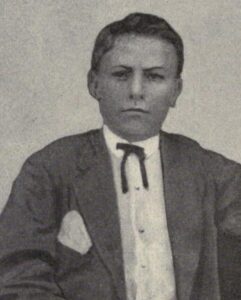 was married Mamie and he quit working for LX Ranch. He opened a tobacco store in Caldwell, Kansas. He and Mamie had a daughter named Viola, born on February 28, 1885. At this point, it seemed prudent to find a safer kind of work, so he began writing his autobiography, “A Texas Cow Boy; Or Fifteen Years on the Hurricane Deck of a Spanish Pony.” A year later, it was published and well received. Siringo moved his family to Chicago in the spring of 1886 for publication of a second printing.
was married Mamie and he quit working for LX Ranch. He opened a tobacco store in Caldwell, Kansas. He and Mamie had a daughter named Viola, born on February 28, 1885. At this point, it seemed prudent to find a safer kind of work, so he began writing his autobiography, “A Texas Cow Boy; Or Fifteen Years on the Hurricane Deck of a Spanish Pony.” A year later, it was published and well received. Siringo moved his family to Chicago in the spring of 1886 for publication of a second printing.
In 1886, Siringo witnessed the Chicago Haymarket affair. “The Haymarket affair (also known as the Haymarket massacre, the Haymarket riot, or the Haymarket Square riot) was the aftermath of a bombing that took place at a labor demonstration on May 4, 1886, at Haymarket Square in Chicago, Illinois, United States. It began as a peaceful rally in support of workers striking for an eight-hour workday, the day after police killed one and injured several workers. An unknown person threw a dynamite bomb at the police as they acted to disperse the meeting, and the bomb blast and ensuing gunfire caused the deaths of seven police officers and at least four civilians; dozens of others were wounded.”
Seeing all that destruction prompted Siringo to join the Pinkerton National Detective Agency. He used gunman Pat Garrett’s name as a reference to get the job, having met Garrett in 1880, when they were searching for Billy the Kid. Siringo was hired immediately, and assigned to Denver, reporting to James McParland. He moved his family to Denver, where his wife died in 1890, leaving him with his young daughter to raise. Eventually she went to live with his wife’s aunt and her husband, Emma and Will F Read. Siringo was then assigned several 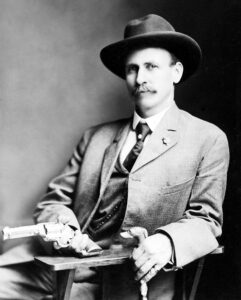 cases, which took him as far north as Alaska, for the Treadwell mine, and as far south as Mexico City. Using a relatively new technique at the time, he began operating under cover as Charles L Carter and infiltrated gangs of robbers and rustlers, making more than 100 arrests.
cases, which took him as far north as Alaska, for the Treadwell mine, and as far south as Mexico City. Using a relatively new technique at the time, he began operating under cover as Charles L Carter and infiltrated gangs of robbers and rustlers, making more than 100 arrests.
Siringo had a difficult married life, following his first wife’s death. It makes you wonder if he would have stayed married, had she lived. A second marriage in 1893 to Lillie Thomas ended in divorce after three years. They had a son named William Lee Roy. After the divorce, Lillie took their son and moved to Los Angeles. Two other marriages, one in 1907 to a woman named Grace and one in 1913 to a woman named Ellen Partain. Each of these lasted only a few months. Finally, Siringo moved to California to be closer to his children. In the end, it wasn’t his cowboy years or his detective years that really made Siringo famous, but rather his writing. Siringo was the author of seven books. Siringo died on October 28, 1928, in Altadena, California.
 My niece, Jenny Spethman is my sister, Cheryl Masterson’s youngest child, and sometimes it’s still hard for me to believe that she is all grown up and a mother of 5 children, one of whom is graduating from high school this year. Jenny seems to take family life so much in stride. Oh, I know there are kid struggles, as there are in any family, but all in all Jenny and her husband, Steve Spethman have been very successful, and they have raised wonderful kids.
My niece, Jenny Spethman is my sister, Cheryl Masterson’s youngest child, and sometimes it’s still hard for me to believe that she is all grown up and a mother of 5 children, one of whom is graduating from high school this year. Jenny seems to take family life so much in stride. Oh, I know there are kid struggles, as there are in any family, but all in all Jenny and her husband, Steve Spethman have been very successful, and they have raised wonderful kids.
As I think about Jenny, I find myself with the same thoughts over and over…a love of God, humbleness, and kindness. Those are things not everyone can have said about them. Jenny is one of those people who absolutely ooze those things. She doesn’t put on airs or act conceited. Those traits live strongly in her heart, and as the Bible says, “A good man out of the good treasure of 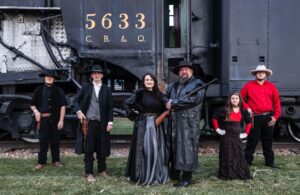 his heart brings forth good; and an evil man out of the evil treasure of his heart brings forth evil. For out of the abundance of the heart his mouth speaks.” Luke 6:45. That is very true of Jenny. I don’t think I have ever heard her speak an unkind word to or about anyone. It just really isn’t in her.
his heart brings forth good; and an evil man out of the evil treasure of his heart brings forth evil. For out of the abundance of the heart his mouth speaks.” Luke 6:45. That is very true of Jenny. I don’t think I have ever heard her speak an unkind word to or about anyone. It just really isn’t in her.
These days, Jenny works part-time at the law firm where her mom, works, and everyone there absolutely loves her. Jenny could go full time, and in fact they have offered that to her. Of course, that would mean being in an office all day, and not the “runner” she is now, but Jenny likes being the runner. She runs errands that need done for the office, such as taking legal  documents to the courthouse, going to the post office, and anything else they need someone to do outside the office. She also helps out at the reception desk for lunch and breaks for the receptionist. By running their errands, Jenny has developed a great relationship with everyone in the office, and they dearly love her. It’s not that Jenny and Steve need the money anyway, it’s just what Jenny calls “Mad Money” and that is all she wants it to be. Jenny and Steve love to entertain, and she is definitely a fashionista with a flair for the unusual, ina a way that the rest of us are just a bit jealous of. With her “mad money” job, they have the extra money to do all the fun stuff they want to do. Today is Jenny’s birthday. Happy birthday Jenny!! Have a great day!! We love you!!
documents to the courthouse, going to the post office, and anything else they need someone to do outside the office. She also helps out at the reception desk for lunch and breaks for the receptionist. By running their errands, Jenny has developed a great relationship with everyone in the office, and they dearly love her. It’s not that Jenny and Steve need the money anyway, it’s just what Jenny calls “Mad Money” and that is all she wants it to be. Jenny and Steve love to entertain, and she is definitely a fashionista with a flair for the unusual, ina a way that the rest of us are just a bit jealous of. With her “mad money” job, they have the extra money to do all the fun stuff they want to do. Today is Jenny’s birthday. Happy birthday Jenny!! Have a great day!! We love you!!
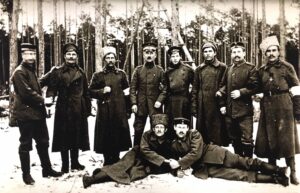 A truce in the context of war, doesn’t always mean a permanent end to the fighting. That is a fact that has often amazed me. If a war can be put “on hold” for a specific reason and a specified timeframe, why must the fighting then resume like the truce never happened? Nevertheless, resume it usually did. Such a truce happened between the German forces fighting the Russians forces in satellite regions like Lithuania and Belarus during World War I. The fighting raged in many different places at that time and continued through the winter of 1917.
A truce in the context of war, doesn’t always mean a permanent end to the fighting. That is a fact that has often amazed me. If a war can be put “on hold” for a specific reason and a specified timeframe, why must the fighting then resume like the truce never happened? Nevertheless, resume it usually did. Such a truce happened between the German forces fighting the Russians forces in satellite regions like Lithuania and Belarus during World War I. The fighting raged in many different places at that time and continued through the winter of 1917.
The intense fighting throughout the heavily forested region and had an unexpected side effect. Any time humans move into an area, the animal  population instinctively moves deeper into wilderness areas where there is less interaction with people, but when the winter is harsh and food becomes scarce, the animals can become as desperate as the humans. In that particular area at that particular time, the Russian wolves were starving. Any prey they might have been able to hunt had vacated because of the intense fighting, and so they had resorted to taking the bodies of the fallen soldiers for food. When there wasn’t enough of that, they began to actively hunt the soldiers, so now the soldiers of the Russian and the German armies had a whole new enemy, and this one could not be reasoned with.
population instinctively moves deeper into wilderness areas where there is less interaction with people, but when the winter is harsh and food becomes scarce, the animals can become as desperate as the humans. In that particular area at that particular time, the Russian wolves were starving. Any prey they might have been able to hunt had vacated because of the intense fighting, and so they had resorted to taking the bodies of the fallen soldiers for food. When there wasn’t enough of that, they began to actively hunt the soldiers, so now the soldiers of the Russian and the German armies had a whole new enemy, and this one could not be reasoned with.
The wolves had progressed from raiding villages to taking corpses to accosting groups of soldiers outright, so 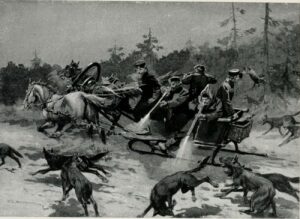 the two armies mutually decided that it was necessary to call a truce so they could rid the area of the unexpected mutual enemy…roving bands of gigantic Russian wolves. They were genuinely in fear for their lives. Wolves often attack in the dark and go for the weakest link or when people are sleeping. It became obvious that this would be a fight to the end…of one or the other…man or beast. So, both armies agreed to a temporary truce and went on a joint campaign of destruction. The wolves could not be allowed to stay, for the sake of anyone in the area. The two armies slew hundreds of wolves, and then simply resumed their fight. How very strange that seems to me, but I guess it probably wasn’t up to the soldiers to walk away from the war.
the two armies mutually decided that it was necessary to call a truce so they could rid the area of the unexpected mutual enemy…roving bands of gigantic Russian wolves. They were genuinely in fear for their lives. Wolves often attack in the dark and go for the weakest link or when people are sleeping. It became obvious that this would be a fight to the end…of one or the other…man or beast. So, both armies agreed to a temporary truce and went on a joint campaign of destruction. The wolves could not be allowed to stay, for the sake of anyone in the area. The two armies slew hundreds of wolves, and then simply resumed their fight. How very strange that seems to me, but I guess it probably wasn’t up to the soldiers to walk away from the war.
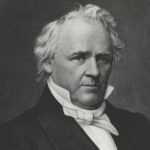
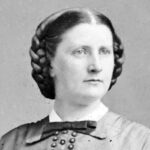 President James Buchanan was the only bachelor president of the United States, and in the absence of a first lady, his niece, Harriet Lane acted as First Lady for him. Lane was born on May 9, 1830, in Stony Batter, Pennsylvania. Her mother died when she was nine, her father when she was 11, and the orphaned girl was remanded to the custody of her mother’s brother, the future President Buchanan. He oversaw the remainder of her childhood, sending her to a prestigious private school in Washington while he was a Senator. Not only was it very unusual for a president not to have a wife, but Buchanan’s niece was only 27 years old when she was acting as first lady. For the wife of a president, that would be a big enough job, but for a young single woman, who may have never hosted a party, much less such large events, that was a big undertaking. Nevertheless, Harriet Lane was not just any young woman. During her time as First Lady, she was considered the greatest First Lady ever. Many would compare her to Jaqueline Kennedy, had they been of similar eras.
President James Buchanan was the only bachelor president of the United States, and in the absence of a first lady, his niece, Harriet Lane acted as First Lady for him. Lane was born on May 9, 1830, in Stony Batter, Pennsylvania. Her mother died when she was nine, her father when she was 11, and the orphaned girl was remanded to the custody of her mother’s brother, the future President Buchanan. He oversaw the remainder of her childhood, sending her to a prestigious private school in Washington while he was a Senator. Not only was it very unusual for a president not to have a wife, but Buchanan’s niece was only 27 years old when she was acting as first lady. For the wife of a president, that would be a big enough job, but for a young single woman, who may have never hosted a party, much less such large events, that was a big undertaking. Nevertheless, Harriet Lane was not just any young woman. During her time as First Lady, she was considered the greatest First Lady ever. Many would compare her to Jaqueline Kennedy, had they been of similar eras.
The work Harriet Lane did as First Lady also earned her the honor of having several ships named after her. In 1859, the United States Revenue Cutter Service named a revenue cutter USRC Harriet Lane. The outbreak of the Civil War, saw USRC Harriet Lane as a ship of the United States Navy and later the Confederate States Navy. The cutter was christened and entered the water for the Revenue Service in 1859 out of New York City. It saw action during the Civil War at Fort Sumter, New Orleans; Galveston, Texas; and Virginia Point. She became a ship for the Confederacy when the Confederate Navy captured her in 1863. The ship was converted to mercantile service. Then the Union forces recaptured her at the end of war. The war was not easy on USRC Harriet Lane, and so the US Navy declared the ship unfit for service and sold her. New owners out of Philadelphia renamed her Elliot Ritchie. Her crew abandoned her at sea in 1881. It was not really a very fitting end for a ship with such stately beginnings.
USRC Harriet Lane measured 177.5 feet long, 30.5 feet wide and 12 feet from the bottom of the hull to the main deck. She had a double-right-angled marine engine with two side paddles, supported by two masts. The entire ship was sheathed and fastened with copper. Her initial armaments were light guns, however after joining the West Gulf Squadron her firepower was upgraded to one four-inch rifled Parrott gun to the forecastle, one nine-inch Dahlgren gun before the first mast, two eight-inch Dahlgren Columbiads and two twenty-four-pound brass Howitzers. Her crew of 95 were also issued small arms. In August 1861, in what would likely be her most famous battle, the Harriet Lane, Monticello, and Pawnee were sent on a sortie from Hampton Roads, Virginia, to blockade runners working in the area. While off the Hatteras they also participated in the first combined arms operation of the Civil War: an amphibious landing to take Fort Hatteras and Fort Clark.
As for the real Harriet Lane, following her time as First Lady, she went to England for a while. During her time in England, Sir Fitzroy Kelly, then Prime Minister Palmerston’s attorney general, proposed marriage to her. Queen Victoria was strongly in favor of this match, as it would keep Lane in England. She was well liked in England and considered an asset. Lane considered the advantages of a number of bachelors. Her uncle cautioned Lane against “rushing precipitately into matrimonial connections.” He found most of her potential suitors “pleasant but dreadfully troublesome.” Lane eventually married Baltimore banker Henry Elliott Johnston at the age of 36. They had two sons, but between 1867 and 1885, her uncle, her husband, and her children had all died. She was alone again.
In 1895, Harriet wrote her will. She lived another eight years, during which the country’s general prosperity greatly increased the value of her estate. In 1899, she amended her will, directing that a school building be constructed on the grounds of the Washington National Cathedral property and asked that it be called the Lane-Johnston Building “to the end that the family names of my husband and myself may be associated with the bequest made in loving memory of our sons.” A codicil of 1903 increased her gift by one third, but said that 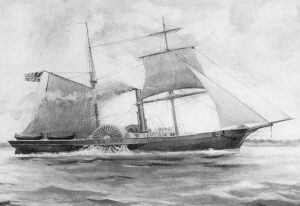
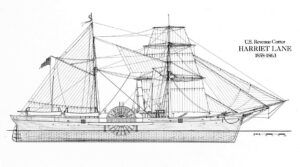 only half the total was to be spent on the building. The remainder was “specially to provide for the free maintenance, education and training of choirboys, primarily those in service of the Cathedral.” This bequest founded the prestigious boys’ school that today is called Saint Albans School, which opened in October 1909. Harriet Lane-Johnston died of cancer on July 3, 1903, in Narragansett, Rhode Island.
only half the total was to be spent on the building. The remainder was “specially to provide for the free maintenance, education and training of choirboys, primarily those in service of the Cathedral.” This bequest founded the prestigious boys’ school that today is called Saint Albans School, which opened in October 1909. Harriet Lane-Johnston died of cancer on July 3, 1903, in Narragansett, Rhode Island.
By guest writer, my niece, Toni Chase, because I couldn’t have said it as perfectly as she did.
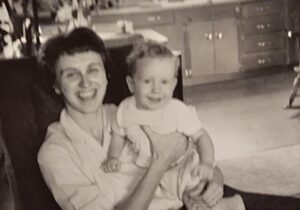
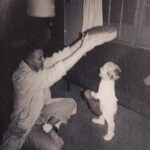 When you first meet a Happiness Bringer, you might wonder, how did this person come to be such a joy to be around? For my (Toni’s) husband, Dave Chase, I think it started manifesting the day his parents arrived in his world. His mother Nancy Chase, who did a spectacular job of journaling the lives of her children wrote, “David loved affection and attention and we (Nancy and Jim Chase) loved showering him with it.” She described his arrival and their time together as “domestic bliss.” Dave was pure happiness for his parents. Dave was followed by his little brother, Dan, who was followed by his little sister, Jane.
When you first meet a Happiness Bringer, you might wonder, how did this person come to be such a joy to be around? For my (Toni’s) husband, Dave Chase, I think it started manifesting the day his parents arrived in his world. His mother Nancy Chase, who did a spectacular job of journaling the lives of her children wrote, “David loved affection and attention and we (Nancy and Jim Chase) loved showering him with it.” She described his arrival and their time together as “domestic bliss.” Dave was pure happiness for his parents. Dave was followed by his little brother, Dan, who was followed by his little sister, Jane.
Dave was a doting brother and from the time his little brother, Dan learned to crawl he became part of “Team Fun” (Dave’s team). They spent hours upon hours having fun with their dad, Jim as children…continuing throughout their adulthood. Dave played whatever sport was in season sometimes on a different team than his two besties, but at home, it was always the three of them having fun. They played basketball together, golfed together, played softball together, fished together, and played cribbage together. For “Team Fun” there was always something to do…and that made everybody happy. On a sidenote, I just thought about…Dave’s brother Dan told me once, “I had the best time growing up!! Dave always made me do everything with him!!” (It makes me teary eyed)
As sports enthusiasts the three of them Dad, Dave, and Dan played on many of the same basketball and softball teams, and as Mother Nancy stated they all played cribbage together! “All Chases play cribbage.” 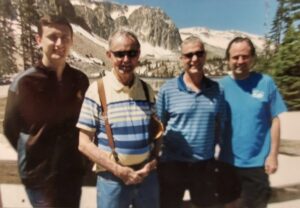
 Including baby Jane who wasn’t a baby anymore. Thank God that Nancy was so attentive in her journaling. Dave’s happy welcoming nature has continued from the day he was introduced to love, happiness, and fun. His beautiful nature began with two loving parents, with so much love in their hearts, that it poured all over and throughout Dave and made him the blessing that he is today.
Including baby Jane who wasn’t a baby anymore. Thank God that Nancy was so attentive in her journaling. Dave’s happy welcoming nature has continued from the day he was introduced to love, happiness, and fun. His beautiful nature began with two loving parents, with so much love in their hearts, that it poured all over and throughout Dave and made him the blessing that he is today.
Dave always keeps himself busy doing fun things. He still plays basketball, softball, cribbage, fishing, and going to as many Wyoming Cowboys football and basketball games as he can…and 2021 was no exception! He spent it doing any of these when he could break away from me. We went to Florida in May and had a nice relaxing time together before we came back to start a new chapter in our lives as our son, James got married.
Dave refused to meddle in the planning of James and Manuela’s wedding. I didn’t feel the need to stay out, and happily assisted with anything they wished for. Dave has always been an exceptional stepdad to James. He loves him and now Dave received the blessing of a daughter, Manuela…who he adores. She is so much like him. I see his loving nature now pouring over on to James and Manuela. The loving nature that he learned and lived thanks to Jim and Nancy Chase.
On October 20, 2021, Dave’s dad, Jim left this world. Dave has missed playing cribbage with him the last several times he’s gone home. He is filling in the time he used to spend having fun with his dad going to games 

 cand hanging out with his mom. He takes her out with the guys and just carries on…because, he knows they can’t play cribbage this season. There’s always next season for that. This is a new season and must be journeyed through. Today is Dave’s birthday. Happy birthday Dave!! Have a great day!! We love you!!
cand hanging out with his mom. He takes her out with the guys and just carries on…because, he knows they can’t play cribbage this season. There’s always next season for that. This is a new season and must be journeyed through. Today is Dave’s birthday. Happy birthday Dave!! Have a great day!! We love you!!
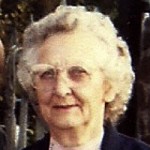
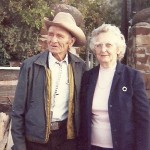 My husband’s grandmother, Vina Hein was an amazing cook. The food she made wasn’t fancy, and in fact I suppose it was what would be called “comfort food” these days. Grandma learned to cook as a girl taking care of her dad and brother after her mother left them when she was about ten years old. She loved her dad and brother, and for a while, it was just the three of them. Then her dad remarried, and things changed again. Grandma didn’t talk about that time much, but she endured and grew to be the wonderful woman that we all knew.
My husband’s grandmother, Vina Hein was an amazing cook. The food she made wasn’t fancy, and in fact I suppose it was what would be called “comfort food” these days. Grandma learned to cook as a girl taking care of her dad and brother after her mother left them when she was about ten years old. She loved her dad and brother, and for a while, it was just the three of them. Then her dad remarried, and things changed again. Grandma didn’t talk about that time much, but she endured and grew to be the wonderful woman that we all knew.
There wasn’t much that Grandma couldn’t handle, and when she married Walt Hein, she became a rancher’s wife. They had a big spread out in the country, and she cooked, canned, helped with the animals, gardened, and kept the house. It was work she had trained for since she was a child. She was destined to be the family matriarch, and she was good at her job. Over the years she helped out with grandchildren when their parents worked, and the kids absolutely loved to be at Grandma’s house. Even the grandchildren who lived far away loved to come to visit Grandma and Grandpa.
My husband, Bob Schulenberg went to stay with Grandma and Grandpa just about every year. He helped out around the ranch, and in general, got to have a great time on his “almost like summer camp” visits. And when he was grown, he still liked to go visit his grandparents. When we got married, he wanted to pass that tradition on to his girls, Corrie Petersen and Amy Royce, and to me. We loved going for visits, and that is something I miss to this day. Grandma didn’t always like to play cards, like Grandpa did, but she would do it for us. You had to have partners, after all. Grandpa would have played for hours, but Grandma had other things to do, so after a couple of hours, Grandpa would head out to the barn to take a nap, while Grandma and our family did other things around the house. He didn’t want to interfere with the dinner preparations, after all. Grandma always 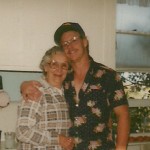
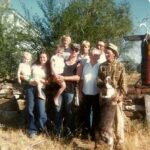 had wonderful things, like real cream, thick and cold, a taste I have never found in a store. Strawberry Rhubarb pie and jelly too. Wonderful home raised beef, and farm fresh eggs. And of course, her canned vegetables and garden-fresh vegetables too. It would have been worth the drive just for Grandma’s good cooking, for sure, and I would sure love to have one of her meals again right now. Today is the 113th anniversary of Grandma Hein’s birth. Happy birthday in Heaven Grandma. We love and miss you very much. And it looks like Punxsutawney Phil says six more weeks of Winter, but I guess that no longer matters to you, like it did when you were a kid.
had wonderful things, like real cream, thick and cold, a taste I have never found in a store. Strawberry Rhubarb pie and jelly too. Wonderful home raised beef, and farm fresh eggs. And of course, her canned vegetables and garden-fresh vegetables too. It would have been worth the drive just for Grandma’s good cooking, for sure, and I would sure love to have one of her meals again right now. Today is the 113th anniversary of Grandma Hein’s birth. Happy birthday in Heaven Grandma. We love and miss you very much. And it looks like Punxsutawney Phil says six more weeks of Winter, but I guess that no longer matters to you, like it did when you were a kid.
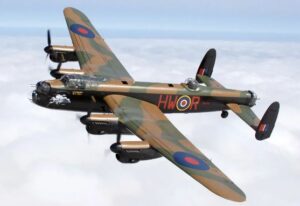 As nations prepare for war, they must also prepare the weapons of warfare. These days, and really since airplanes became reliable enough to be used in war, manufacturers have been building better and better airplanes for war. The Wright brothers, Wilber and Orville made the first airplane, which they successfully flew in 1903. Planes were first used in war in 1911, but it was in World War I, 1914-1918, that their use became commonplace. Since then, we have seen an avalanche of progress is the types and capabilities of planes.
As nations prepare for war, they must also prepare the weapons of warfare. These days, and really since airplanes became reliable enough to be used in war, manufacturers have been building better and better airplanes for war. The Wright brothers, Wilber and Orville made the first airplane, which they successfully flew in 1903. Planes were first used in war in 1911, but it was in World War I, 1914-1918, that their use became commonplace. Since then, we have seen an avalanche of progress is the types and capabilities of planes.
For me, there is no greater warplane than the B-17, but I suppose I am a bit biased because my dad served on a B-17 during World War II. That mkes me very partial to the B-17. It really was a Flying Fortress, and it was that fortress that brought my dad back home. In my book, that makes it the greatest plane ever.
During World War II, the United States had the B-17, otherwise known as the Flying Fortress…among other planes, of course. There was a plane used by Britain, that would have been the similar, to a degree to the abilities to the B-17. The Lancaster was a heavy bomber “workhorse” of a plane. When compared to the B-17, it could carry a heavier payload and fly further than the B-17. The B-17 had higher flight ceiling and better defensive firepower. Speed was about even. Those things are important, but when it came to survivability, the B-17 was the better plane in that it was far easier to bail out of than the Lancaster, meaning that the crew of a plane that was going down would really hope it 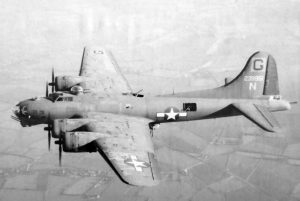 was a B-17. Only 15% of shot down crewmen survived from the Lancaster, while it was around 50% for B-17s. The Lancaster bomber had only one emergency exit…at the front of the aircraft, as opposed to four (counting the bomb bays) for the B-17.
was a B-17. Only 15% of shot down crewmen survived from the Lancaster, while it was around 50% for B-17s. The Lancaster bomber had only one emergency exit…at the front of the aircraft, as opposed to four (counting the bomb bays) for the B-17.
Both of these planes were amazing weapons of war. They were just developed, designed, and built by different companies, and different countries. They served somewhat different purposes, but they were both designed to end the murderous Axis of Evil nations, of which Hitler’s Third Reich and Japan’s evil empire were a huge part. These planes were different, but both were on the side of good and not evil. I think that I am just glad they were on the same side of the war.
 In 1998, two Argentine mountaineers climbing Mount Tupungato, which is about 60 miles west-southwest of Mendoza, and about 50 miles east of Santiago, made a strange discovery emerging from the glacial ice. Upon inspection, the “discovery” turned out to be the wreckage of a Rolls-Royce Merlin aircraft engine, along with twisted pieces of metal and shreds of clothing. It didn’t take long to realize that a plane had crashed here, but when and how did that plane crash at an elevation of 15,000 feet, into the Tupungato Glacier.
In 1998, two Argentine mountaineers climbing Mount Tupungato, which is about 60 miles west-southwest of Mendoza, and about 50 miles east of Santiago, made a strange discovery emerging from the glacial ice. Upon inspection, the “discovery” turned out to be the wreckage of a Rolls-Royce Merlin aircraft engine, along with twisted pieces of metal and shreds of clothing. It didn’t take long to realize that a plane had crashed here, but when and how did that plane crash at an elevation of 15,000 feet, into the Tupungato Glacier.
The find set off an Argentine Army expedition in 2000, during which additional wreckage was found, including a propeller and wheels (one of which had an intact and still inflated tire). The expedition also noted that the wreckage was well localized, which is indicative of a head-on impact with the ground, ruling out a mid-air explosion. In addition to the plane, the expedition found human remains, including three torsos, a foot in an ankle boot, and a manicured hand.
On August 2, 1947, a plane known as the Star Dust, operated by British South American Airlines, took off from Buenos Aires, Argentina, headed for Santiago, Chile. It never made it. After 51 years, the fate of the Star Dust was finally known, but how did it happen? A recovered propeller showed that the engine had been running at  near-cruising speed at the time of the impact. The planes wheels were in a retracted state, meaning that the plane wasn’t coming in for a landing, emergency or planned. This was a controlled flight into terrain, whether planned or unplanned. It was determined that during the final portion of Star Dust’s flight, there would have been heavy clouds blocking the visibility to the ground. It is thought that because of the cloud cover and the resulting absence of visual sightings, that a large navigational error could have been made as the aircraft flew through the jet stream. This would not have been understood in 1947. High-altitude winds can blow at high speed in directions different from those of winds observed at ground level. If the airliner, which had to cross the Andes Mountain Range at 24,000 feet, had entered the jet-stream zone, which in this area normally blows from the west and south-west, resulting in the aircraft encountering a headwind, this would have significantly decreased the aircraft’s ground speed.
near-cruising speed at the time of the impact. The planes wheels were in a retracted state, meaning that the plane wasn’t coming in for a landing, emergency or planned. This was a controlled flight into terrain, whether planned or unplanned. It was determined that during the final portion of Star Dust’s flight, there would have been heavy clouds blocking the visibility to the ground. It is thought that because of the cloud cover and the resulting absence of visual sightings, that a large navigational error could have been made as the aircraft flew through the jet stream. This would not have been understood in 1947. High-altitude winds can blow at high speed in directions different from those of winds observed at ground level. If the airliner, which had to cross the Andes Mountain Range at 24,000 feet, had entered the jet-stream zone, which in this area normally blows from the west and south-west, resulting in the aircraft encountering a headwind, this would have significantly decreased the aircraft’s ground speed.
If the crew thought their airspeed was faster than it actually was, the crew may have deduced that they had already safely crossed the Andes, and so commenced their descent to Santiago, when in reality they were still a considerable distance to the east-north-east and were approaching the cloud-shrouded Tupungato Glacier at high speed. That theory is not well received by some BSAA pilots, who have expressed skepticism. They were convinced that Cook would not have started his descent without a positive indication that he had crossed the  mountains, they have suggested that strong winds may have brought down the craft in some other way. One of the pilots recalled that “we had all been warned not to enter cloud over the mountains as the turbulence and icing posed too great a threat.”
mountains, they have suggested that strong winds may have brought down the craft in some other way. One of the pilots recalled that “we had all been warned not to enter cloud over the mountains as the turbulence and icing posed too great a threat.”
A 2000 Argentine Air Force investigation cleared Captain Cook of any blame, concluding that the crash had resulted from “a heavy snowstorm” and “very cloudy weather,” as a result of which the crew “were unable to correct their positioning.” By 2002, the bodies of five of the eight British victims had been identified through DNA testing.
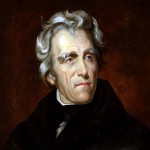
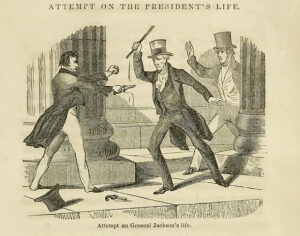 Over the course of American history, several presidents have been assassinated, and several others have survived attempted assassinations. Some were quickly treated, and others were not where the would-be assassin thought they were going to be. Still, Andrew Jackson, the seventh US president better known as “Old Hickory” was, without doubt, the most amazing one. and for good reason, as one would-be assassin found out.
Over the course of American history, several presidents have been assassinated, and several others have survived attempted assassinations. Some were quickly treated, and others were not where the would-be assassin thought they were going to be. Still, Andrew Jackson, the seventh US president better known as “Old Hickory” was, without doubt, the most amazing one. and for good reason, as one would-be assassin found out.
On January 30, 1835, Richard Lawrence came up to the 67-year-old Jackson, as he left a congressional funeral and pulled a pistol on him. I’m sure he thought a 67-year-old man was going to be an easy target, but when he pulled the trigger, the gun misfired. While having his gun misfire was…inconvenient, Lawrence also found out that a 67-year-old man is not necessarily a weak, old man. A furious Jackson began beating the man viciously with his cane in retaliation. Then, while trying to dodge the cane wielded by Jackson, Lawrence managed to pull a second gun from his jacket and pull the trigger. I don’t know how, but Lawrence had to be either the unluckiest assassin, or a totally inept gunman, because the second gun also jammed. By this point, Jackson’s aides were able to wrestle Lawrence away and into custody. Jackson was unharmed. 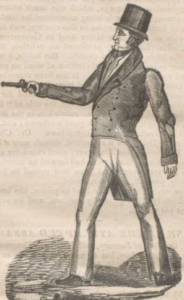
Jackson became convinced that the attempt was made at the behest of his political enemies, even though all evidence pointed to Lawrence being a mentally unstable lone wolf. I rather think I might agree with Jackson on this one, because politics can be a deadly career to get into. Jackson spent the rest of his presidency worried about another attack, while his vice president, Martin Van Buren, started carrying two loaded pistols with him into the Senate.
You can take away any opinion on this matter that you want to, but I have my own. I find it amazing that Jackon had the wherewithal to “pull” his cane on his would-be assassin, but how often to you see two different guns misfire in the commission of the same assassination. I see that situation as nothing but God. Jackson was the recipient of a double miracle. If either of those gun shots would have connected to their mark, he would surely have been dead. This was not a sniper shooter, but rather, a close-range shooter, and would have meant instant death. No, this man was divinely protected, and that’s all there is to it.

